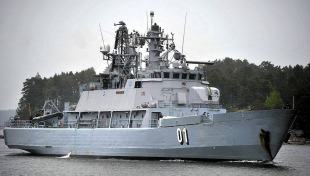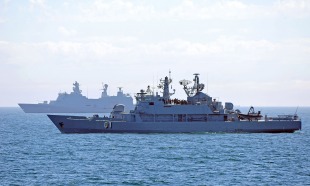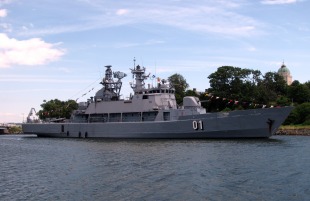Мінні загороджувачі класу Pohjanmaa
Основна інформація
Головні розміри
Машина
- 2 * Wärtsilä Vasa 16V22
- 4,280 kW (5,740 hp) (combined)
- 2 * shafts; controllable-pitch propellers
Персонал
Бойові сили та засоби
- Signaal DA05 radar
- Philips 9LV 220 FCS
- Simrad hull-mounted sonar
- Decoy: Philax chaff and IR flares
- ESM: Argo Systems radar warning system
- 1 * Bofors 120 mm/46 (pre 1996)
- 1 * Bofors 57 mm/70 Mk1 (post 1998)
- 1 * Bofors 40 mm/70
- 2 * Sako twin-barrel 23 mm/87 (modified ZU-23-2)
- 2 * NSV 12.7 mm machine guns
- 2 * rails for depth charges
- 4 * rails for 150 mines (Sea Mine 2000)
Pohjanmaa, previously a minelayer for the Finnish Navy, stands as the sole representative of her category. She held the position of the Finnish Navy's flagship and served as the most sizeable maritime craft in Finland until 2013. Equipped with a Finnish-Swedish ice classification 1A, this vessel had the capability to operate seamlessly throughout the year. In moments of crisis, Pohjanmaa's primary functions encompassed mine deployment and assuming command duties. Additionally, it functioned as an educational platform for Naval Academy cadets, involving an annual overseas journey as part of their curriculum.
The 34-year-old Pohjanmaa was slated for retirement by late 2013. In October 2013, the minelayer Hämeenmaa took over the flagship role in the Finnish Navy.
In 2016, Pohjanmaa was transferred to the Finnish enterprise Meritaito and underwent a transformation into a survey vessel. It was renamed Pohjanmeri, meaning the North Sea in Finnish.
The construction of Pohjanmaa dates back to 1979 at the Wärtsilä Helsinki Shipyard in Finland. Initially, it was armed with a Bofors 120 mm Automatic Gun L/46.
Initially serving as an instructional vessel for the Naval Academy, Pohjanmaa was reassigned to the Gulf of Finland Fleet (now known as the Gulf of Finland Naval Command) in 1992. Upon completion, it took the place of the minelayer Ruotsinsalmi and, as a training vessel, succeeded Matti Kurki. On May 10, 1982, it was granted the customary emblem of ocean-faring vessels previously held by Suomen Joutsen, effectively continuing the legacy of the three ships. The ship underwent an extensive modernization program from 1996 to 1998, involving the replacement of its Bofors 120 mm L/46 main gun with a more contemporary dual-purpose Bofors 57 mm Naval Automatic Gun L/70.
The annual cadet training voyage has taken the vessel as far as Belém, Brazil. The vessel's capacity for extended voyages can be expanded using additional accommodation containers.
On June 28, 2005, as part of its voyage, Pohjanmaa participated in the International Fleet Review, a component of the Trafalgar 200 celebrations.
In 2007, the vessel underwent renovation alongside the Hämeenmaa-class minelayers, shifting its color scheme from camouflage to light grey. Its secondary aft gun was also removed from the rear deck due to restricted shooting sectors, further constrained by a larger hydraulic crane for a new seaboat.
In 2010, a decision was made for Pohjanmaa to partake in Operation Atalanta in 2011. On April 6, 2011, Pohjanmaa intercepted a vessel suspected to be a pirate mothership along with two speedboats. An onboard search revealed assault rifles, RPGs, and other weaponry. Eighteen of the suspected pirates were detained on board Pohjanmaa. As the Prosecutor General of Finland chose not to pursue charges, the pirates were transferred to the jurisdiction of Operation Atalanta, subsequently being released. The pirate vessels were intentionally sunk at sea.
Pohjanmaa was christened on June 8, 1979, by Aili Haapkylä. The name originates from the Swedish-built pojamas of the 1770s — refer to «Pohjanmaa (disambiguation)» for alternate uses of the name.
The vessel earned the nickname Puuhamaa from Finnish Navy conscripts, inspired by a Finnish amusement park.
Despite upgrades, the over 30-year-old Pohjanmaa reached the conclusion of its operational lifespan in the mid-2010s and was retired in late 2013 as a minelayer. It will be succeeded by a next-generation surface combatant, larger than the existing missile boats and more adept at international cooperation. Additionally, the new category of multi-purpose naval vessels—named MTA2020 (Monitoimialus 2020) in initial documentation—is intended to replace the retiring Hämeenmaa-class minelayers and Rauma-class missile boats.
Upon Pohjanmaa's decommissioning, it was stated that the vessel would either be sold or scrapped if a suitable buyer was not found. In September 2013, reports surfaced that the Estonian Navy expressed interest in acquiring the vessel. However, Estonia later opted against the purchase. The Croatian Navy also indicated interest, with their representatives even visiting Finland to inspect the vessel. The Finnish towing and salvage company Alfons Håkans also proposed to purchase the vessel, but their offer was declined.
On December 18, 2015, it was declared that Pohjanmaa would be sold for dismantling. The vessel was slated for disassembly in Finland, with an expected cost of approximately 248,100 euros. The engines and some equipment were to be sold to offset part of the expenses. However, by March 2016, reports indicated the cancellation of the dismantling, with plans to sell the vessel to Meritaito, the Finnish state-owned shipping company that manages fairway support vessels. The vessel underwent disarmament and conversion into a survey ship at Western Shipyard in Salo, Finland, following plans drawn by the Finnish design company ILS Oy.
Кораблі1
- Коментарі
 uk
uk en
en ru
ru



 Військово-Морські Сили Фінляндії
Військово-Морські Сили Фінляндії